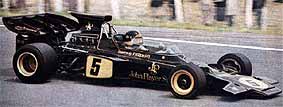Ciro Pabón wrote:I differ.
Yes, higher profiles offer a lot of advantages, they give better traction, they are more forgiving, easier to drive, less prone to damage etc. etc.
However, in terms of absolute performance in a car relying so much on the undertray, they are ultimately inferior.
Very often I hear the explanation that the cars need the high profile because the suspension is so stiff, as if the suspension was a fixed parameter that needed to be adjusted by the design of the tires.
It is like saying that it is cold in the Arctic because of all the ice, or because the polar bears have got thick fur.
I am not a fan of ultra low profile tires, the have got narrow tracking angles, thus giving little warning to the driver, they have got no "wind up" in acceleration, thus providing less manageable traction off corners, they easily get damaged on curbs, they are sensitive to wrong tire pressure,..... I could go on forever.
One thing in favour of ultra low profiles; you have got a much better response to changes in suspension set-up. If that is a good thing, when you get it wrong it's horrible, like many of us have experienced when swapping our perfectly working standard tires on our road cars for something that really requires a retuned suspension.
Would the cars be quicker if the suddenly were fitted with 18" rims? No, not for a while, they would be slower, crashing more often and leave a lot of frustrated drivers stranded in gravel traps or worse. They would probably struggle to get the power down off the corners, particularly without TC.
What would happen though, in the longer perspective, is more sensitive aerodynamics, with undertrays producing more downforce in a narrower window of operation.
"Rules are for the interpretation of wise men, and the obedience of fools." -Colin Chapman-
"Trying is the first step towards failure." -Homer Simpson-





